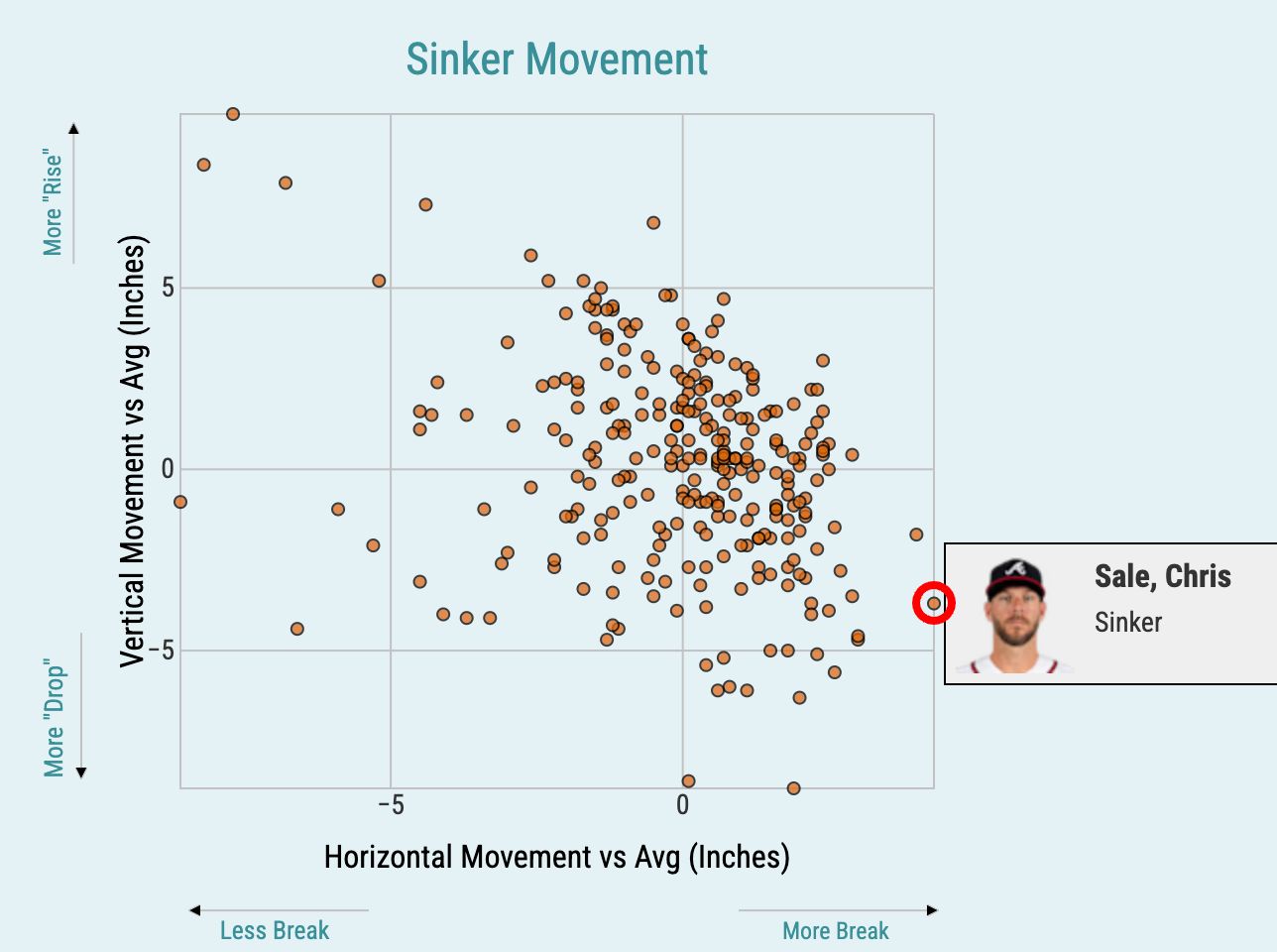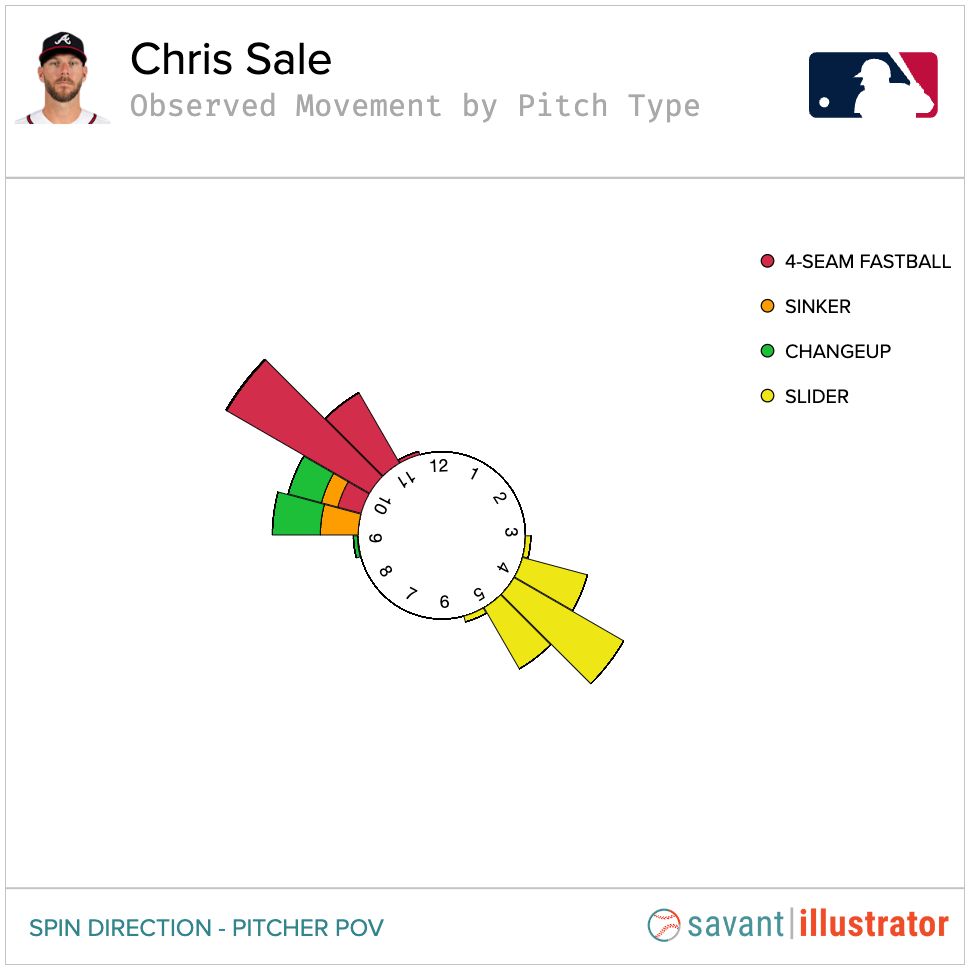The Braves traded for Chris Sale with the postseason in mind. But what can bring Sale back to his old form with his new team?
The main thing, obviously, is his health. The Braves are banking on Sale being able to last into October. Last year, Sale made 20 starts in a season for the first time since 2019. But the left-hander hasn't made 30 starts in a year, or qualified for the ERA title by innings pitched, since 2017, when he was at his peak.
Sale doesn't need to be that 300-strikeout pitcher for the Braves. But if he can get his groove back over a full season with Atlanta, Sale will make this 2024 Braves rotation extremely formidable.
Here's how he can do it.
First things first: Sale is already pitching better than you might think
Sale's 4.30 ERA in 20 starts last season won't blow you away, but you should take note of some of the numbers around that ERA. Especially his strikeout numbers.
Sale still struck out almost 30% of the batters he faced in 2023, and he averaged 11 K's per nine innings. The difference between his strikeout rate (29.4%) and walk rate (6.8%) was top 10 in the Majors among pitchers who threw at least 100 innings. Those are all excellent numbers.
Sale's K/9, for example, was actually right in line with his career mark, 11.1 … and he's the all-time leader in that category. And if he maintained his 29.4% strikeout rate over a full season's workload, he'd still be a 200-plus strikeout pitcher.
Sale faced 425 batters in 2023 and struck out 125 of them. If he faced the 700-800 batters that he would over a full, 30-start season, and posted the same K%, that'd put him in the 200-230 strikeout range for his season total. And that would be among the Major League leaders.
Statcast can also combine Sale's strikeouts with his quality of contact allowed to generate an expected ERA. In 2023, Sale's expected ERA was 3.61. That looks a lot better than 4.30, and actually put him right around the top quarter of Major League pitchers.
Among the 139 pitchers who faced at least 400 batters last season, Sale's expected ERA ranked in the top 15, right between Tyler Glasnow and Logan Webb.
Sale continues to be very good at most of the things that go into being a very good pitcher:
- He generated a swing-and-miss rate close to 30%, ranking in the 75th percentile of MLB pitchers
- He induced a chase rate of over 33%, ranking in the 92nd percentile of MLB
- His hard-hit rate allowed, just under 35%, was in the 80th percentile of MLB
- The expected batting average against him was just .211, in the 85th percentile of MLB

Second: He could take a page out of Max Fried's book
Fried, the Braves' resident lefty ace who Sale will be joining, has made one interesting change to his repertoire over the last couple of seasons: He's started throwing two different types of sliders. Fried now throws both a traditional slider -- harder, with more tight vertical movement -- and the new "sweeper" style of slider, with big horizontal break.
Sale, if he's looking to try something new, could draw some inspiration from his new teammate. Sale's signature slider, which has produced over 1,000 strikeouts over the course of his career, already comes all the way across the plate at the hitter thanks to his crossfire delivery. And it's still a nasty pitch entering 2024. But Sale's actually lost some of the sweeping action on his slider recently.
In 2023, Sale's slider averaged 11 inches of horizontal break. That's still a good amount -- but over his first few seasons with the Red Sox from 2017-19, his slider was averaging 13-14 inches of horizontal break.
It's actually gone from far above-average movement, when compared to other big league sliders thrown with similar velocity and release points, to slightly below-average movement. That's not exactly what Sale wants from one of the most infamous pitches in baseball.
What his slider did continue to get in 2023 was sharp vertical drop. And a more vertical slider, with less sweep and more drop, can still work for Sale, because he can throw it off of his elevated four-seam fastballs, going from the top of the zone to the bottom.
But Sale's sweeping sidearm slider has historically been his greatest weapon. If he can get back those few inches of sweep -- while still also throwing some more vertical sliders on top of that -- he'll be able to take more full advantage of his arsenal.
Third: He could go the opposite way of Spencer Strider
Sale taking full advantage of his arsenal means getting more use out of his two other pitches, his sinker and his changeup.
In his prime, Sale could dominate with two pitches: fastball-slider. He'd rack up over 100 strikeouts on both of those pitches, season after season. That might remind you of the Braves' other ace, Strider, who just led the Majors with 281 strikeouts as essentially a two-pitch pitcher, fastball-slider, just like Sale used to be.
But Sale doesn't have quite the same raw, overpowering stuff that he used to five years ago. That's fine. But as a veteran southpaw, he already has two extra weapons at his disposal that he can use to keep on rolling.
Sale's sinker and changeup haven't always given him the results he wants in recent seasons, but from a stuff perspective -- specifically, their movement -- they're pitches he should try to harness. Especially to use in concert with sweeping sliders.
Sale's sinker, which he only threw 6% of the time in 2023 compared to 43% for his four-seamer, averaged over 28 inches of drop and close to 20 inches of run. That's well above-average movement in both directions -- about four inches more drop and more run than a typical sinker. In fact, Sale got the most run on his sinker of any pitcher last season.

His changeup, which he only threw 13% of the time, has similarly impressive horizontal movement, fading over 18 inches on average. That's also about four inches more horizontal movement than a typical changeup.
The key there is that those two pitches break in the opposite direction of the Sale slider. If he released his slider, sinker and changeup the same way, there's about a 30-inch span between where the slider's movement would take it compared to the sinker and changeup. The sinker and changeup move as mirrors to Sale's slider, which should allow him to use them to attack hitters, especially right-handed hitters, across the strike zone horizontally.

All four of Sale's pitches are good enough to merit a place in his repertoire in Atlanta, and if he can stay on the mound to throw them all season, the Braves' pitching staff will be strongly positioned for another playoff run.
